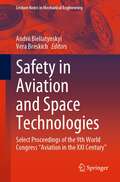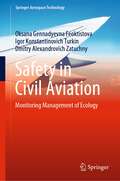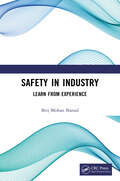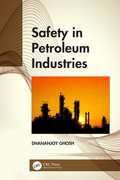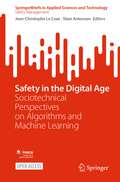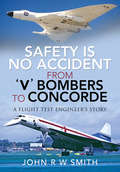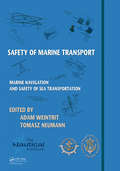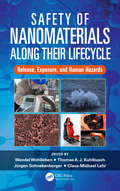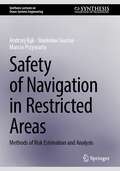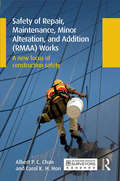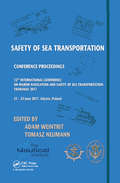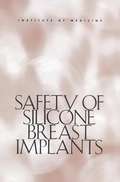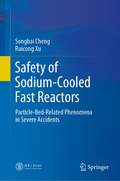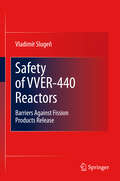- Table View
- List View
Safety for Particle Accelerators (Particle Acceleration and Detection)
by Thomas OttoThe use of non-standard technologies such as superconductivity, cryogenics and radiofrequency pose challenges for the safe operation of accelerator facilities that cannot be addressed using only best practice from occupational safety in conventional industry. This book introduces readers to different occupational safety issues at accelerator facilities and is directed to managers, scientists, technical personnel and students working at current or future accelerator facilities. While the focus is on occupational safety – how to protect the people working at these facilities – the book also touches on “machine safety” – how to prevent accelerators from doing structural damage to themselves. This open access book offers a first introduction to safety at accelerator facilities. Presenting an overview of the safety-related aspects of the specific technologies employed in particle accelerators, it highlights the potential hazards at such facilities and current prevention and protection measures. It closes with a review of safety management and organization at accelerator facilities.
Safety in Aviation and Space Technologies: Select Proceedings of the 9th World Congress "Aviation in the XXI Century" (Lecture Notes in Mechanical Engineering)
by Vera Breskich Andrii BieliatynskyiThis book gathers the latest advances, innovations, and applications in the field of aerospace technology and aviation safety, as presented by researchers at the 9th World Congress “Aviation in the XXI Century”: Safety in Aviation and Space Technologies, held in Kyiv, Ukraine, on April 26-28 2021. It covers highly diverse topics, including carbon neutral aviation, precision engineering in aerospace, robots in the aerospace industry, nanotechnology for aerospace, aircraft design and strength, tribotechnology in aviation, engines and power installations, intelligent robotic and measuring systems, control systems, civil aviation cybersecurity, mathematical modeling and numerical methods, aeronavigation, unmanned aerial complexes, environmental safety and aviation chemmotology, aviation transport logistics, and construction of transport facilities. The contributions, which were selected by means of a rigorous international peer-review process, highlight numerous exciting ideas that will spur novel research directions and foster multidisciplinary collaborations.
Safety in Civil Aviation: Monitoring Management of Ecology (Springer Aerospace Technology)
by Dmitry Alexandrovich Zatuchny Oksana Gennadyevna Feoktistova Igor Konstantinovich TurkinThis book presents a methodology for assessing environmental safety in civil aviation. The methodology allows the comparison of different technological processes and evaluates their impact on the environment. At the same time, the medical and demographic indicators for ecologically unfavorable territories are compared with similar indicators in the control (background) territories in the same climatic and geographical zones. This book contains methodological recommendations for the creation of the system for ecology safety in the organizational structures of civil aviation. This book is useful to a wide audience—students of aviation, lecturers, as well as specialists in the field of ecology and those involved in ensuring the necessary ecology requirements at aviation enterprises.
Safety in Design
by C.M. van LandExpert insight and guidance on integrating safety into design to significantly reduce risks to people, systems, property, and communities Safe design refers to the integration of hazard identification and risk assessment methods early in the design process so as to eliminate or minimize the risks of catastrophic failure throughout the life of a system, process, product, or service. This book provides engineers, designers, scientists and governmental officials with the knowledge and tools needed to seamlessly incorporate safety into the design of civil, industrial, and agricultural installations, as well as transportation systems, so as to minimize the risk of accidents and injuries. The methodology described in Safety in Design originates from the continuous safeguarding techniques first developed in the chemical industry and can successfully be applied to a range of industrial and civil settings. While the author focuses mainly on the aspects of safe design, he also addresses procedures which have a proven track record of preventing and alleviating the impacts of accidents with existing designs. He shares lessons learned from his nearly half-century of experience in the field and provides accounts of mishaps which could have been prevented, or significantly mitigated, based on data collected from approximately seventy incidents that have occurred in various countries. • Describes the application of safe design in an array of fields, including the chemical industry, transportation, farming, the building trade, and leisure • Reviews the history of intrinsic process safeguarding, which was first used in the chemical industry to minimize the risk of human error or instrumentation failure • Describes dozens of preventable incidents to illustrate the critical role safe design can play • Provides expert guidance and valuable tools for seamlessly weaving safety into every phase of the design process Safety in Design is an indispensable working resource for chemical, civil, mechanical, risk, and safety engineers, as well as professional R&D scientists, and process safety professionals. It is also a useful reference for insurers who deal with catastrophic loss potentials, and for government personnel who regulate or monitor industrial plants and procedures, traffic systems, and more.
Safety in Industry: Learn from Experience
by Brij Mohan BansalThis concise book presents years of the author’s practical experiences on industrial safety through various case studies. It aims to quip professionals in their respective industrial fields with different safety management systems, like the knowledge of common dos and don’ts, Standard Operating Procedures (SOP), and even the Emergency handling and use of PPEs. Print edition not for sale in South Asia (Bangladesh, Bhutan, India, Nepal, Pakistan and Sri Lanka)
Safety in Petroleum Industries
by Dhananjoy GhoshSafety in Petroleum Industries covers pertinent safety aspects and precautions to be taken for design, operation, maintenance, inspection and project constructions for petroleum industries, with an emphasis on petroleum refineries. Relevant practical knowledge and experience contributing to safe and sustained operation of the industry has been compiled with all necessary references. Identified areas where theoretical inputs are required have also been incorporated. Learning objectives for the petroleum industries have been identified and discussed in an organized manner based on author’s more than thirty-five years of experience in petroleum and chemical industries. Aimed at practicing engineers in upstream and downstream petroleum industries, this book: Covers safety tips for operation of petroleum industries Documents design codes, tools and practices including safe operating practices of different equipment and safety procedures in a single source Includes detailed safety procedures like HAZOP, Safety Audit, management safety review, and process safety management Contains dedicated chapters on Fire Fighting, and Industrial Hygiene and Ergonomics Discusses first-hand experienced examples and burning issues in the petroleum industry
Safety in the Digital Age: Sociotechnical Perspectives on Algorithms and Machine Learning (SpringerBriefs in Applied Sciences and Technology)
by Jean-Christophe Le Coze Stian AntonsenThis open access book gathers authors from a wide range of social-scientific and engineering disciplines to review challenges from their respective fields that arise from the processes of social and technological transformation taking place worldwide. The result is a much-needed collection of knowledge about the integration of social, organizational and technical challenges that need to be tackled to uphold safety in the digital age.The contributors whose work features in this book help their readers to navigate the massive increase in the capability to generate and use data in developing algorithms intended for automation of work, machine learning and next-generation artificial intelligence and the blockchain technology already in such extensive use in real-world organizations.This book deals with such issues as:· How can high-risk and safety-critical systems be affected by these developments, in terms of their activities, their organization, management and regulation?· What are the sociotechnical challenges of the proliferation of big data, algorithmic influence and cyber-security challenges in health care, transport, energy production/distribution and production of goods?Understanding the ways these systems operate in the rapidly changing digital context has become a core issue for academic researchers and other experts in safety science, security and critical-infrastructure protection. The research presented here offers a lens through which the reader can grasp the way such systems evolve and the implications for safety—an increasingly multidisciplinary challenge that this book does not shrink from addressing.
Safety in the Underground Construction and Operation of the Exploratory Studies Facility at Yucca Mountain
by U.S. National Committee on Tunneling TechnologyYucca Mountain, located on the Nevada Test Site, is being considered as a potential repository site for spent nuclear fuel and high-level radioactive waste. To determine the suitability of Yucca Mountain as a repository, the Department of Energy constructed an underground Exploratory Studies Facility (ESF) where tests and experiments will be performed. This book addresses safety issues which will impact the construction and operation of the ESF and other similar underground facilities. The authors discuss proactive strategies for underground safety management with an emphasis on planning for safety, safety regulations, and the enforcement of such regulations. Also included are illustrations of successful approaches in creating a safe environment for those who work underground.
Safety is No Accident—From 'V' Bombers to Concorde: A Flight Test Engineer's Story
by John R. SmithA behind-the-scenes look at the aeronautical engineers who keep the skies safe. Many are surprised to learn that flying is, statistically, the safest means of transportation. Even less well known is the crucial role that flight test observers and engineers play in ensuring that level of safety. In this book, one of them recounts his experience as an aeronautical engineer working in partnership with test pilots, painting a vivid portrait of his flight-testing career from the 1960s to early 1980s at Avro and the UK&’s Civil Aviation Authority (CAA). During the author&’s time at Avro, he flew on the development and certification test flights of the Avro 748, 748MF, Shackletons, Nimrod, and Handley-Page Victor tanker. In the CAA, his role turned to regulation, making flight test assessments of manufacturer&’s prototypes and production aircraft, to check compliance with the CAA&’s flight safety requirements. The scope ranged from single-engine light aircraft to large civil transport aircraft. It involved frequent visits to foreign manufacturers and also included his participation in the CAA&’s Concorde certification flight test program. Advancements in the understanding of aerodynamics and an increasingly professional approach to risk management improved safety, but flight testing still involves risk, and several of the author&’s close friends and colleagues died in flight test accidents during this period. It is because of the courage and expertise of such people that millions of flights now touch down safely each year.
Safety of Irradiated Foods (ISSN)
by J.F. DiehlThis work examines the exaggerations, misunderstandings and muddled terminology that often characterize the controversies regarding the safety of food irradiation. It sets out to untangle the conflicting claims asserted by the proponents and opponents of this modern method of food processing. Information is drawn from international scientific and p
Safety of Marine Transport: Marine Navigation and Safety of Sea Transportation
by Adam Weintrit Tomasz NeumannProviding high-quality, scholarly research, addressing development, application and implications, in the field of maritime education, maritime safety management, maritime policy sciences, maritime industries, marine environment and energy technology. Contents include electronics, astronomy, mathematics, cartography, command and control, psychology, operational research, risk analysis, theoretical physics, operation in hostile environments, instrumentation, ergonomics, financial planning and law. The book provides a forum for transportation researchers, engineers, navigators, ergonomists and policy-makers with an interest in maritime researches.
Safety of Meat and Processed Meat
by Fidel ToldráSafety of Meat and Processed Meat provides the reader with the recent developments in the safety of meat and processed meat, from the abattoir along the processing chain to the final product. To achieve this goal, the editor uses five approaches. The first part deals with the main biological contaminants like pathogen microorganisms, specially E. coli and L. monocytogenes, toxins and biogenic amines that can be present either in meat or its derived products. The second part focuses on main technologies for meat decontamination as well as developments like active packaging or bioprotective cultures to extend the shelf life. The third part presents non-biological contaminants and residues in meat and meat products including nitrosamines, PAH, veterinary drugs and environmental compounds. The fourth part discusses current methodologies for the detection of microorganisms, its toxins, veterinary drugs, environmental contaminants and GMOs, and the final part deals with predictive models, risk assessment, regulations on meat safety, consumer perception, and other recent trends in the field. This book is written by distinguished international contributors with excellent experience and reputation. In addition, brings together advances in different safety approaches.
Safety of Nanomaterials along Their Lifecycle: Release, Exposure, and Human Hazards
by Wendel Wohlleben Thomas A. J. Kuhlbusch Claus-Michael Lehr SchnekenburgerThe incorporation of nanomaterials into products can improve performance, efficiency, and durability in various fields ranging from construction, energy management, catalysis, microelectronics, plastics, coatings, and paints to consumer articles such as foods and cosmetics. But innovation never comes at zero risk. The potential hazards resulting fr
Safety of Nanoparticles
by Thomas J. WebsterIn spite of the potential use of nanomaterials as tissue engineering devices, implants, biosensors, drug delivery devices, etc., there has yet to be a compilation of the risks associated with the in vivo use of nanomaterials. There are numerous and well-known risks because of the size of nanoparticles. For example, nanoparticles can cross cell membranes and enter the cytoplasm undetected. The aim of this book is to provide one of the first (if not the first) detailed views of how cells and tissues in the body deal with nanoparticles. This is important not only for implantable devices, but also for the manufacturing of nanophase materials when particles can be inhaled or enter the body through the skin. Only by compiling research at the intersection of nanoparticles and biological processes can we determine if nanophase materials are safe to be manufactured, handled, and/or implanted for various medical applications.
Safety of Navigation in Restricted Areas: Methods of Risk Estimation and Analysis (Synthesis Lectures on Ocean Systems Engineering)
by Andrzej Bąk Stanisław Gucma Marcin PrzywartyThe themes of this monograph include modern engineering problems of marine traffic engineering, focusing on what this discipline deals with: navigational safety assessment methods. These include: criteria of assessing navigational safety in restricted areas, navigation risk, as a complex criterion of navigational safety assessment in waterway systems, models of navigation risk determination used worldwide, conditions of safe operation of ships on waterways determined by using navigation risk, minimum safe tug assistance on port waterways, navigation risk management in waterway systems with a description of a computer program for model-based tests of navigational safety on Southern Baltic waterways.
Safety of Repair, Maintenance, Minor Alteration, and Addition (RMAA) Works: A new focus of construction safety
by Albert P. Chan Carol K. HonSafety of RMAA works is an almost uncharted topic of rising importance internationally. Small construction contractors are particularly dependant on RMAA work, especially during times of recession, and they undertake more risks on these jobs than large companies do. This book is based on unique international research and consultancy projects which detail, investigate, and suggest solutions to the specific challenges of safety in RMAA works, based on case studies. Starting with an overview of safety in the wider construction industries of developed countries, the first half of this book also provides a comprehensive summary of relevant rules, regulations, and the resulting safety performances. The systems in the UK, US and Hong Kong are described and contrasted, giving the reader an understanding of how different regulatory approaches have yielded a variety of results. From this solid introduction, specific problems observed in RMAA work are examined through case studies, with reference to the underlying cultural and demographic factors, and a variety of practical engineering and management solutions are explored. This important and practical international work is essential reading for postgraduate students of health and safety in construction, construction project management, or construction in developing countries, as well as policy-makers and construction project managers.
Safety of Sea Transportation: Proceedings of the 12th International Conference on Marine Navigation and Safety of Sea Transportation (TransNav 2017), June 21-23, 2017, Gdynia, Poland
by Adam Weintrit Tomasz NeumannSafety of Sea Transportation is the second of two Conference Proceedings of TransNav 2017, June 21-23 in Gdynia, Poland. Safety of Sea Transportation will focus on the following themes:Sustainability, intermodal and multimodal transportationSafety and hydrodynamic study of hydrotechnical structuresBunkering and fuel consumptionGases emission, water pollution and environmental protectionOccupational accidentsSupply chain of blocks and spare partsElectrotechnical problemsShips stability and loading strengthCargo loading and port operationsMaritime Education and Training (MET)Human factor, crew manning and seafarers problemsEconomic analysisMathematical models, methods and algorithmsFisheryLegal aspectsAviation
Safety of Silicone Breast Implants
by Institute of MedicineThe Dow Corning case raised serious questions about the safety of silicone breast implants and about larger issues of medical device testing and patient education.Safety of Silicone Breast Implants presents a well-documented, thoughtful exploration of the safety of these devices, drawing conclusions from the available research base and suggesting further questions to be answered. This book also examines the sensitive issues surrounding women's decisions about implants. In reaching conclusions, the committee reviews: The history of the silicone breast implant and the development of its chemistry.The wide variety of U.S.-made implants and their regulation by the Food and Drug Administration.Frequency and consequences of local complications from implants.The evidence for and against links between implants and autoimmune disorders, connective tissue disease, neurological problems, silicone in breast milk, or a proposed new syndrome.Evidence that implants may be associated with lower frequencies of breast cancer. Safety of Silicone Breast Implants provides a comprehensive, well-organized review of the science behind one of the most significant medical controversies of our time.
Safety of Sodium-Cooled Fast Reactors: Particle-Bed-Related Phenomena in Severe Accidents
by Songbai Cheng Ruicong XuThis book highlights the advances and trends in the safety analysis of sodium-cooled fast reactors, especially from the perspective of particle bed-related phenomena during core disruptive accidents. A sodium-cooled fast reactor (SFR) is an optimized candidate of the next-generation nuclear reactor systems. Its safety is a critical issue during its R&D process. The book elaborates on research progresses in particle bed-related phenomena in terms of the molten-pool mobility, the molten-pool sloshing motion, the debris bed formation behavior, and the debris bed self-leveling behavior. The book serves as a good reference for researchers, professionals, and postgraduate students interested in sodium-cooled fast reactors. Knowledge provided is also useful for those who are engaging in severe accident analysis for lead-cooled fast reactors and light water reactors.
Safety of VVER-440 Reactors
by Vladimír SlugenSafety of VVER-440 Reactors endeavours to promote an increase in the safety of VVER-440 nuclear reactors via the improvement of fission products limitation systems and the implementation of special non-destructive spectroscopic methods for materials testing. All theoretical and experimental studies performed the by author over the last 25 years have been undertaken with the aim of improving VVER-440 defence in depth, which is one of the most important principle for ensuring safety in nuclear power plants. Safety of VVER-440 Reactors is focused on the barrier system through which the safety principle is organised: * nuclear fuel matrix; * fuel cladding; * integrity of primary circuit; and * confinement system. All these barriers are described in detail and are compared to European standards. Industrial engineers will find Safety of VVER-440 Reactors a useful guide to the safe operation of nuclear power plants and it is an informative source of information for researchers in both industry and academia. Employees of related governmental and regulatory organisations may also benefit from reading this book.
Safety with Machinery
by John Ridley Dick PearceJohn Ridley and Dick Pearce, both recognized specialists in machinery safety, guide the reader through the various standards, regulations and best practices relating to the safe design and use of machinery and show which standard is relevant for which type of machine. Safety with Machinery provides a basic grounding in machinery safety and covers safeguarding philosophy and strategy, typical hazards, risk assessment and reduction, guarding techniques, ergonomic considerations, safe use of equipment and plant layout. All types of safeguards are discussed – mechanical, interlocking, electrical / electronic / programmable, hydraulic, pneumatic.The new edition has been updated throughout in line with changes in regulations and standards. The section on electric, electronic and programmable safety systems has been expanded to reflect their increasing importance. The book now focuses on the harmonised standards (e.g. EN ISO 13849, IEC/EN 61131-2) which can be used by manufacturers to self-certify their machines for the European market without the need for third party examination, but also covers other relevant standards (e.g. IEC 62061). Many practical examples set the regulations in context and assist in the interpretation of the various standards.Safety with Machinery is essential reading for all engineers involved in machinery design and maintenance all over the world as every machine sold within or into the EU needs to conform to the harmonised standards. It also provides health and safety professionals, students and employee representatives, as well as certification bodies, health and safety inspectors and safety regulators with a comprehensive overview of machinery safety.
Safety, Health And Environmental Auditing: A Practical Guide, Second Edition
by Simon Watson PainThis new edition builds on the success of the first edition. It has been enhanced to embrace new topics including Due Dilgence, EHS Auditing, Process Safety Auditing, and a chapter summarizing auditing with the relevant ISO standards. The rest of the book has been updated to fit with the guidance and requirements set out with the changes in the ISO standards. The goal of this book remains the same, to provide a "down to earth" guidance for managers and specialists in organizations who are committed to improving their safety, health, and environmental performance, but are not sure where to start or do not wish to employ consultants to do this for them, They do it themselves using this book.
Safety, Health and Environmental Auditing: A Practical Guide, Second Edition
by Simon Watson PainThis new edition builds on the success of the first edition. It has been enhanced to embrace new topics including Due Dilgence, EHS Auditing, Process Safety, Auditing, and a chapter summarizing auditing with the relevant ISO standards. The rest of the book has been updated to fit with the guidance and requirements set out with the changes in the ISO standards. The goal of this book remains the same, to provide a "down to earth" guidance for managers and specialists in organizations who are committed to improving their safety, health and environmental performance, but are not sure where to start or do not wish to employ consultants to do this for them. They do it themselves using this book. <P><P>Features <li>Integrates the concepts of safety health and environmental auditing into a common approach of "loss prevention" <li>Provides an audit protocol for 60 aspects of safety, health, and environmental management <li>Presents a summary of the requirements of ISO 9001 and ISO 14001 to auditing Introduces the novel and unique concept of Auditing Convergence <li>Offers a simple auditing software (The Plaudit II audit process) in an electronic program which no other book on this topic can offer
Safety, Health and Welfare in Agriculture and Agro-Food Systems: Ragusa SHWA 2023 (Lecture Notes in Civil Engineering #521)
by Marcello Biocca Eugenio Cavallo Massimo Cecchini Sabina Failla Elio Romano Remigio BerrutoThis book gathers the latest advances, innovations, and applications in the fields of agricultural biotechnology, agro-food systems and forestry, as presented by leading international researchers and engineers at the 7th International Conference on Safety, Health and Welfare in Agriculture and Agro-food Systems (SHWA), held in Ragusa, Italy, on September 6–9, 2023. The papers cover a range of topics such as agricultural assistive technologies, machine milking, animal welfare, sustainable livestock farming, work organization and logistic in agro-food supply chain, agricultural instrumentation and equipment, safety and health in building, agriculture 4.0, automation, occupational health, precision farming, effect of landscapes on human health, environmental safety, rural health, agricultural machinery, ROPS, augmented reality and IoT, cyber security. The contributions included in the book were selected by means of a rigorous peer-review process and offer an extensive and multidisciplinary overview of interesting solutions in the field of sustainable agriculture.
Safety, Health and Welfare in Agriculture and Agro-food Systems: Ragusa SHWA 2021 (Lecture Notes in Civil Engineering #252)
by Marcello Biocca Eugenio Cavallo Massimo Cecchini Sabina Failla Elio RomanoThis book gathers the latest advances, innovations and applications in the field of agricultural biotechnology, agro-food systems and forestry, as presented by leading international researchers and engineers at the 5th International Conference on Safety, Health and Welfare in Agriculture and Agro-food Systems (SHWA), held in Ragusa, Italy, on September 15-18, 2021. The papers cover a range of topics such as agricultural assistive technologies, machine milking, animal welfare, sustainable livestock farming, work organization and logistic in agro-food supply chain, agricultural instrumentation and equipment, safety and health in building, agriculture 4.0, automation, occupational health, precision farming, effect of landscapes on human health, environmental safety, rural health, agricultural machinery, ROPS, augmented reality and IoT, cyber security. The contributions included in the book were selected by means of a rigorous peer-review process, and offer an extensive and multidisciplinary overview of interesting solutions in the field of sustainable agriculture.

